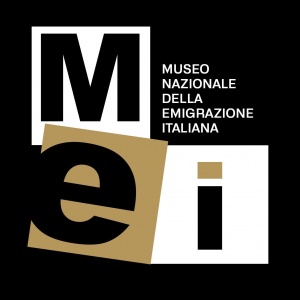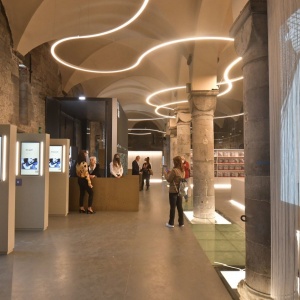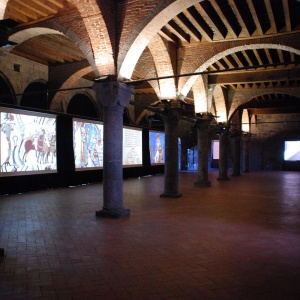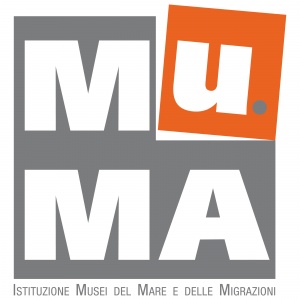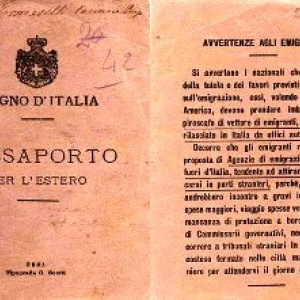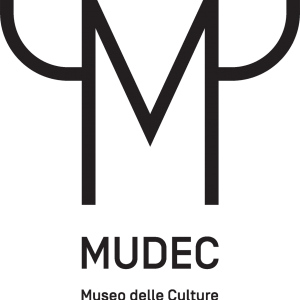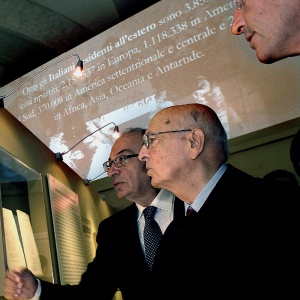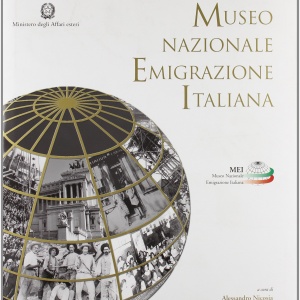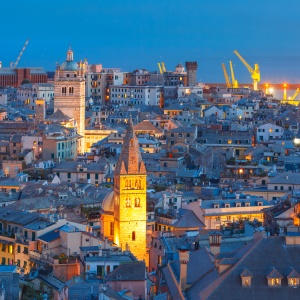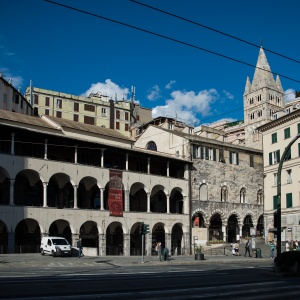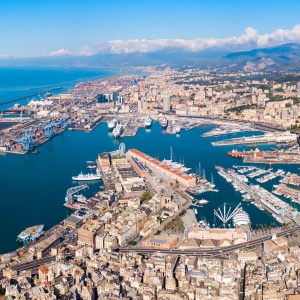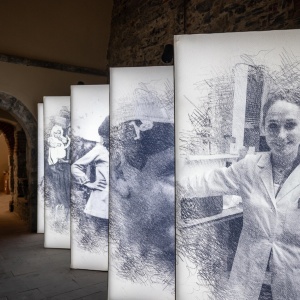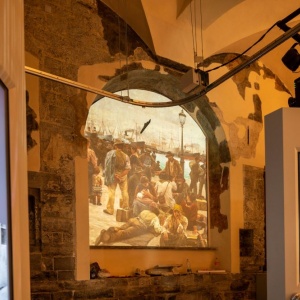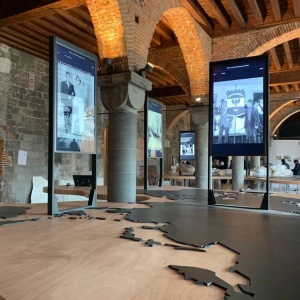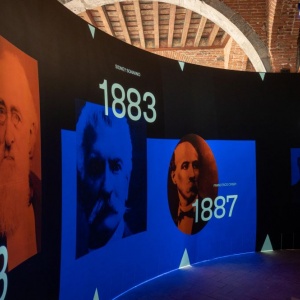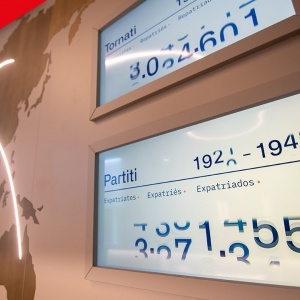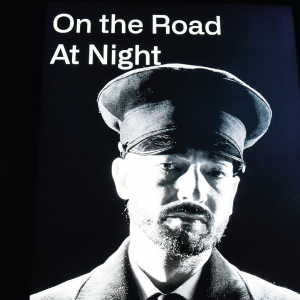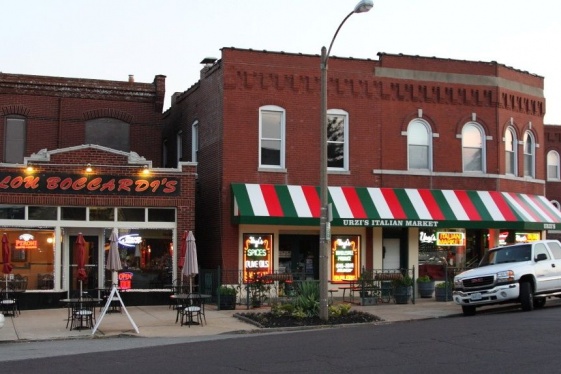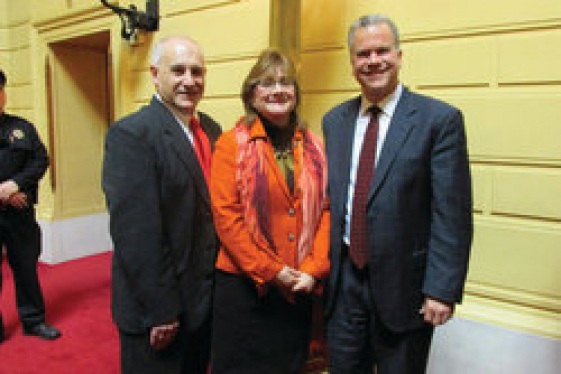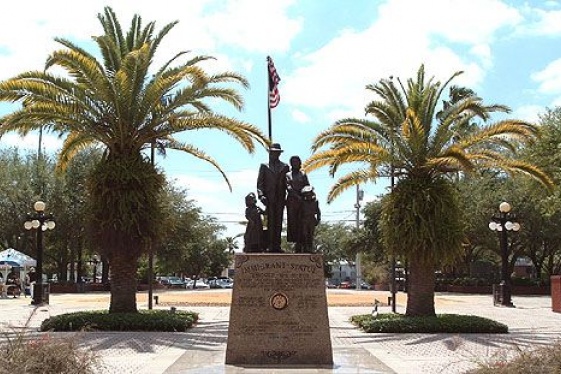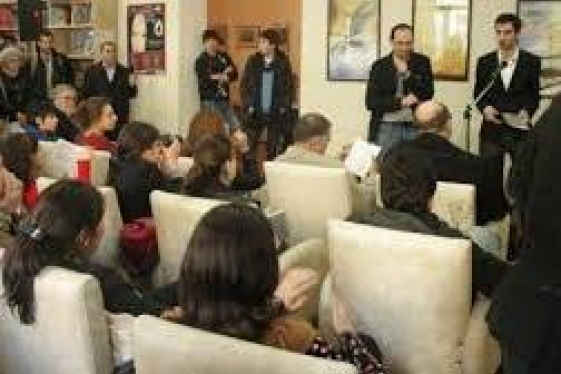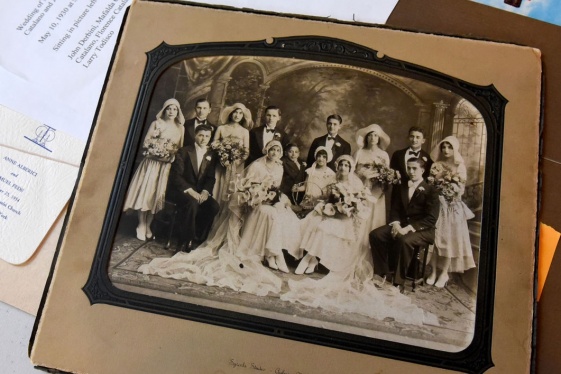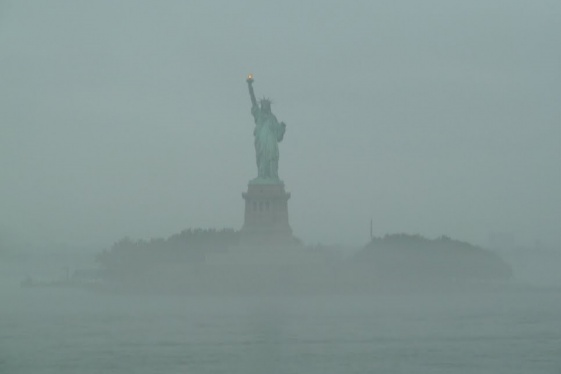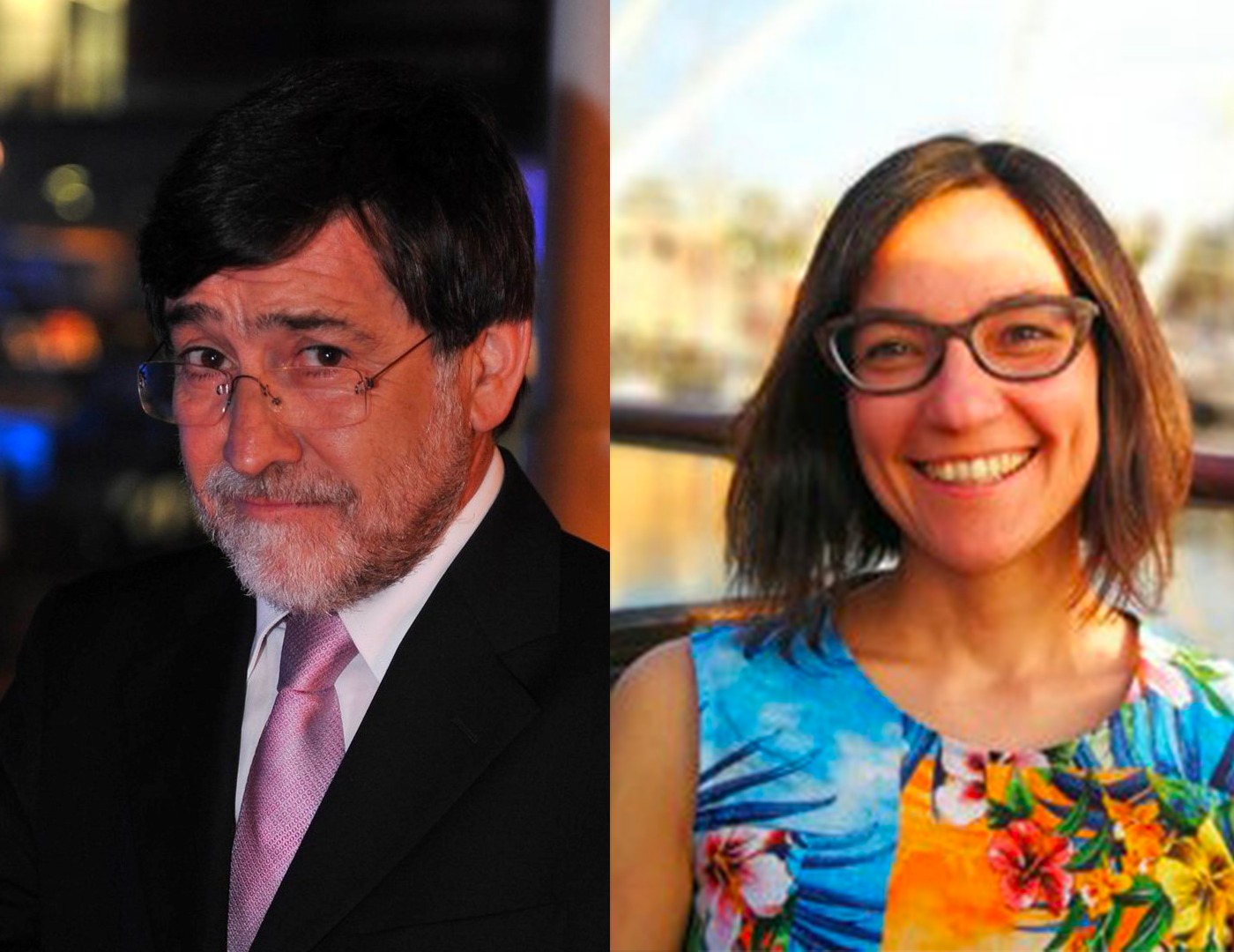
Pierangelo Campodonico and Giorgia Barzetti (National Museum of Italian Emigration)
Benvenuti al Museo Nazionale dell’Emigrazione Italiana

The National Museum of Italian Emigration (MEI) is a magnificent institution that finally pays tribute to the stories of millions of Italians who have left our country: in the distant past or even recently, from every place in Italy, heading for every place in the world.
It is a diaspora that Italy has not yet fully come to terms with, a trauma that it has not yet fully processed, and that prevents our country from looking in the way that would be right at its sons and daughters, far away with their bodies but close with their hearts. We thank and welcome on We the Italians Pierangelo Campodonico and Giorgia Barzetti, respectively Director and Curator of this very important Italian institution, the National Museum of Italian Emigration.
You have two careers really full of studies, publications and experiences dedicated to emigration. I ask you to briefly summarize these two great expertise
(Pierangelo Campodonico) I don't start from a history of emigration as far as my study career is concerned, I'll get to that later. There is one thing I do claim, though, and that is the fact that I lived a family history of emigration. My mother was a daughter of Italian descendants in Brazil, there she met my father, an Italian prisoner of war from a merchant ship during World War II. Then they married, and being a war bride, like many other brides of that era, she changed continents and came to stay in Italy. From Italy, in 1960 my family moved one more time to Brazil for a few years, the years of my early childhood, from ages 2 and 6, but in 1964 in a critical phase for Brazil it was decided to go back, and this time for good. This affected me, because as a child I was the "Brazilian" for the Italian school and, as a child, I experienced that déracinement related to migration.
At first, following somewhat in my father's footsteps I was supposed to be destined to sail, but eventually I realized that I preferred to devote myself more to history and then I landed in the curatorship of the Naval Museum of Genoa, which later became Galata Museo del Mare. From there on, my history goes hand in hand with that of the Museum.
At the beginning of the 2000s, we discovered how within our collections there were actually many testimonies of emigration stories, and from this an intuition: migration and seafaring, in the history of Italians have been "traveling companions." Therefore, we tried to reevaluate this heritage of ours, starting precisely from the United States, which played a central role in this.
In 2007 we went to New York and met our colleagues from Ellis Island, with whom we began a collaboration that lasts to this day and with which we are very pleased. Thus was born a very interesting exhibition called "From Genoa to Ellis Island, the great migration at the time of 1892-1914." A crucial period in Italian history, interrupted because of the First World War.
Another turning point came in 2012, with the creation of what we called the "MEM Pavilion" (an acronym for Memory and Migration), which basically talks about emigration by sea on the three great destinations that alternated in Italian history: chronologically first the one to Argentina, around 1870, then in 1880 to Brazil, and then the last, but also the most substantial, starting in 1892 to the United States.
The operation becomes organic, from that moment the Galata Museo del Mare and above all the Istituzione Mu.MA - Musei del Mare e della Navigazione that directs it, of which Dr. Barzetti and I are part, becomes the Istituzione Musei del Mare e della Migrazioni, "conjugating" these two terms. To my knowledge it is unicum, in the sense that many other nations have followed paths on emigration and the sea, but none has organically connected them.
In those years, we are talking about 2012-15, a somewhat different perception begins in Italy than in the past on the subject of migration, and so we begin to tell not only about ancient and past migration but also about contemporary migration. And we take note of an evidence: if there is a subject that changes quickly, it is precisely the subject of migration: it changes because both the perception of society and the role of migrants in society change. As we had the opportunity to verify thanks to our friends at Fondazione Migrantes, the migration issue - which might have seemed to the eyes of many as a closed chapter of the past, relegated to a history we might say "twentieth-century" - in contrast, it reopened after 2008, and it affects many young and not only young Italians.
In 2016, only four years after making the first pavilion that talked about the new migration, we were forced to make another one with a different focus. One that took note of how what was a situation read in the first decade of the new millennium as an emergency, was instead a consolidated situation, with many people who sum up to almost 10% of the Italian population - with all the differences of the case at the level of the national territory - and who are, in fact, the "new Italians."
The last step in this journey was the creation of the Museo Nazionale dell’Emigrazione Italiana, National Museum of Italian Emigration. There was a fairly long and complex phase to structure an agreement with different entities that were to be part of it: in 2018, the City of Genoa was commissioned to realize it, and we traveled quite fast, first for the planning part, then for the realization part. These are the years when, to our team, Dr. Barzetti was added, who played a very important role in the realization of the exhibition: and we finally managed to open the museum in May 2022.
We compare ourselves with other realities abroad that deal with emigration. Certainly in Italy there are many local museums of different sizes that deal with this issue: we know them, with many of them we have very good collaborations, to some of them we have made a small contribution in terms of materials and implementation input. But I have to say that it was also mainly the comparison abroad that helped us to evolve our museology of migration and to arrive at a result, which is this year's, that we are proud of. It seems to us, in fact, that ours is a rather innovative museum, realized not on the basis of physical collections but on the sharing of a series of digitized materials made available by museums, archives, associations and individuals.
(Giorgia Barzetti) I come to the migration topic through a career path, my previous job was at Mudec, the Museum of Cultures in Milan where I was in charge of the Milan City World project alongside the communities of international migrants living in Milan. The project was also developed with a view to encouraging awareness of the presence of these communities within the urban fabric in order to foster an approach to the topic of migration that was cultural and not simply welfare-based.
Through the skills I had acquired in that field, I was then given the opportunity to join Dr. Campodonico's team that carried out the project related to the National Museum of Italian Emigration, turning over the skills I had acquired dealing with immigration from the world to Italy, putting them at the disposal of the description of the opposite journey, from Italy to abroad, in contact with Italian communities in the rest of the world that have faced and are facing issues, problems, criticalities but also positive aspects similar to those who arrive from outside in our country.
And so since the end of 2020, I have been accompanying the project of creating the MEI exhibition together with my colleague Dr. Nicla Buonasorte. Our role has also been to coordinate activities with the other research organizations, archives, local and international museums that have collaborated with us to study and collect the documents and testimonies that are inside the museum, together with the staff of professionals from the multimedia world who have worked with us. This is because since the National Museum of Italian Emigration is a new museum that does not have a historical tradition behind it, nor a heritage of collections of objects, collections or documents, the choice was digitization. None of the institutions that collaborated with us had to deprive themselves of their original collections or documentation, and this allows us to enhance all those local realities that do not have the visibility that a museum of national importance, such as MEI, can have instead.
Dr. Barzetti, on this subject: what, if any, are the differences and similarities between the world of foreign immigration in Italy and the world of Italian emigration abroad, focusing if possible on that in the United States?
(Giorgia Barzetti) This is a very complicated question that I can only partially answer. In my experience I have only seen similarities in the attitude of communities, but it must be said that I have dealt with the migration phenomenon in Italy by analyzing the contemporary, not the historical aspects. MEI also analyzes these dynamics from different aspects, with the help of anthropologists, sociologists and historians. In the aspects related to the relationship with the family of origin, the work context, eating habits, religious habits and attachment to cultural and - for example - musical traditions, I have to say that both in my experience related to the Peruvian community in Milan (which is the last of the projects I followed in Milan before moving to Genoa) and then going to hear the Italian communities in South America, Australia and the United States, I found many similarities. The affection and connection to cultural traditions, even those that perhaps the generations before had rejected in an effort to integrate more, are very similar.
For example, the classic question "do you feel Italian or do you feel you are of the nationality of your parents' country," asked to the second-generation kid whose parents migrated to Italy, is the same as that asked of the American kid born in the United States to Italian parents who migrated from Italy. In these cases, the answers are often "I feel very Italian when I speak in Italian with my grandmother" but also "I feel American when I play with my friends," but the same happens to children born here to foreign parents who have migrated, where the first answer replaces Italian with Spanish or other languages of origin, and in the second, the children of migrants feel Italian when they play with their friends of their own age.
In my experience, then, there are many more similarities than differences, even on more topical issues such as those of incidents of discrimination and racism. There is the ability of the new generations to feel part of the country in which they are born, in which they grow up (if they arrived there as children), the difficulty of not understanding why some people don't seem to want to accept them, and the great gratitude to those who deal with these major issues: "Is there really interest in talking about us?" they ask with surprise and amazement in both types of communities.
Please remind our readers of the history of the Museum of Italian Emigration, which was founded in Rome in 2009 and housed in the Vittoriano complex until, in my opinion very rightly, it was moved to Genoa
(Pierangelo Campodonico) Until the first decade of the 2000s, emigration was mostly talked about in small local museums, arranged a bit all along the peninsula. Then there were the Paolo Cresci Foundation in Lucca and other institutions dedicated to this theme, however at the overall national level and also as an interest on the part of the Italian state, it began to be followed only around the years 2006- 2007; also, not by chance we start with our own path in those years. The then President of the Republic Giorgio Napolitano was undoubtedly a key player because he had very much in mind the issue of emigration; another very important element was the appearance on the political horizon of the members of Parliament elected by Italians abroad, with Mirko Tremaglia and, with him, a whole series of other people representing different political options. President Napolitano was decisive and strongly wanted the first Museum of Italian Emigration to be born in Rome at the Vittoriano, and certainly helpful was the action of the first representatives of Italians abroad.
I believe that the realization of the first museum and the location at the Vittoriano, was partly dictated by the haste for the 2011 celebrations as the 150th anniversary of the unification of Italy, and partly also by the lack of specialists, historians and museologists who were experts in this topic, although highly developed in the academy. So what happened is that the initial realization was entrusted to a private company that gave birth to an interesting but improvable result. Perhaps the most appropriate thing to remember is a large catalog, also rich in data and information, with a very rich iconography that actually represented a first reflection at the Italian level on Italian emigration. Then there were choices, in my opinion, that were a bit questionable, because emigration is different depending on the time, the region of departure and also the region of arrival: so to provide a sign for each region saying what its emigration was like, is not precisely a very scientifically valid operation. Anyway, it was an experiment, a kind of permanent exhibition, which already after a few years showed the need to be rethought, but it was still an important beginning.
But, as we were saying before, migrations are something alive and dynamic, if you decide to describe them you have to run after them, that is, follow their evolutions and know that, all the time, you have to change your approaches as well: especially if you also want to talk about the present, which changes almost day by day.
Why Genoa is the ideal location for a museum that tells the story of Italian emigration, by historical and geographical features?
(Pierangelo Campodonico) The choice on Genoa was guided by at least three factors. Liguria - and Genoa in particular - has always been a major hub of emigration by sea: it certainly played a minor role in emigration to Europe, however, many people passed through Genoa on their way to the United States, but first to Argentina and Brazil, then to Australia.
In addition, Genoa has had a great history of maritime entrepreneurs and emigration agents: over time it has built several networks in this area, it has seen a great movement of people, interests and services grow.
The second factor is that Genoa has been a port of passage, a port but also a "gateway," so out of here one went but also came in. For example in the 1960s there was a great phenomenon of African (both from the Maghreb and sub-Saharan Africa) and Latin American immigration here: so the gateway worked both ways, outbound but also inbound.
But in this characteristic of being a gateway, there is no regional prevalence. I try to explain myself: certainly many regions, from Veneto to Sicily have had a much larger flow of migration than Liguria, which is a small region and with a limited population. But making the museum in these places carried a risk, that the regional (own) narrative would become prevalent. On the contrary, the criterion in the will of those who wanted the new Museum of Italian Emigration wanted to be just another: the museum had to be national. And that is how we realized it. For example, when we signed up the readers who speak in the various multimedia installations of our museum, they have a little bit all the regional declinations, they speak in the various Italian dialects or regional languages, from Trentino to Sicily, precisely because what we want to convey is not a Ligurian emigration or the history of Ligurians, but that of all Italians with their different characteristics.
Finally, the third factor for which we were chosen was probably coming from the experiences we had made, first with the Ellis Island exhibition and then with the Galata, the MEM and so on: they had been the first nationwide ones visited by substantial amounts of people, who had therefore to some extent started a journey.
The Museum's location, the Commenda di San Giovanni di Prè, and the neighborhood in which it stands, have great historical significance in reference to Italian emigration...
(Giorgia Barzetti) The Commenda di San Giovanni di Pré is one of the best-preserved medieval buildings in the city of Genoa. Founded in 1180, the entire complex is made up of two churches, one lower and the other upper, with the building that is the hospice next to it, which is then actually the museum's home. The building underwent transformations in the XV century that led it to have its current appearance while maintaining its original Romanesque style. It is a building that has gone through several alterations and fortunately in the late 1990s it was decided for a complete restoration that would bring it as close as possible to its original conformation. This gave possibility in 2009 to open the Commenda as a museum-theater, then to make it a place where conferences, exhibitions, performances were held on the theme of interculturality and migration and specifically also on the relations between the different shores of the Mediterranean. A place alive and participated, dedicated to welcome and inclusion and to the production of content that would allow the different international communities present in Genoa not to feel foreign within our city.
Our museum is housed inside this building which is really quite fascinating, and even those who could not come to see it immediately can see it through the virtual tour that is available on our website.
The neighborhood where the museum is located is one of the most intercultural and interethnic neighborhoods in the city, and it is very lively and animated by different associations. Its is a history common to all the neighborhoods near the port in other cities, places of comings and goings, of seafaring traffic, of criminal activity but also a destination area of the first Italian internal migration to Genoa. The fact that we have chosen to place the museum inside the Commenda is a choice that we hope will have a propulsive capacity for development and cultural incentive to the neighborhood.
How is the museum structured?
(Giorgia Barzetti) Dr. Campodonico has already introduced the special feature of the museum, which is that it is a multimedia museum. There are 16 areas developed on the 3 floors of the Commenda in which we have organized a chronological narrative with thematic inserts that tell the story of Italian migrations from the Unification of Italy to contemporary times. There are multimedia stations, installations, films with scenes that include the presence of actors from different regional backgrounds precisely to emphasize the national character of the project.
There is a 360-degree theater where we have explored some themes such as the relationship between politics and migration, and then the different positions that Italian politics has taken, the historical right and left, fascism, war, up to the contemporary with President Mattarella's speech. Thus the visitor has opportunities both to learn about the stories of individual migrants and the historical and political context within which the migrations take place.
The heart of the museum is area A07, which we called “destination world”, because we wanted to emphasize the experiences of Italians in different countries of arrival, not dedicating a room to each individual regional migration, and showing how the lives of Italian migrants developed once they arrived in the country of destination. In this section there are nearly 200 stories collected through collaboration with various archives, museums, and research institutes in which the visitor can discover aspects of daily life or how the lives and vicissitudes of individuals go to intersect with the great events of History, and thus understand the joys, sorrows, defeats, and successes of migrants.
One section that Dr. Campodonico absolutely wanted is the section on the second floor, which is called "The Maze." It is literally a series of cubes stuck one on top of the other in which the visitors are invited to enter and somehow get lost and live the direct experience of integration by putting themselves in the shoes of the Italian migrants in different historical periods and in different countries. Visitors will have to identify themselves and try, for example, to rent a house in Switzerland, confront a French trade unionist in the 1920s, try to get hired by an employer in an American mine in the 1950s, deal with migration from Buenos Aires at the turn of the century, with an employer from Brazil in the late 1800s, and finally with a policeman from the United States in the middle of the night. These experiences, which are all historiographically based on real-life facts, have been reworked into ad hoc scripts and will allow the visitor to experience what Italian emigrants actually experienced on their skin, with situations of great hardship. The visitor is challenged from the first approach because the installations speak the language of the destination country, so they will speak to us in German, French, Spanish, Brazilian, and English. The visitor will have to try to understand what they are being asked and give the answer that fits the context they are in: we have proposed a series of "smart" answers, a series of "less smart" answers, and then the visitor will be able, at the end of this sort of dialogue with the installation, to find a home or not, to be arrested or not, to get a job or to be repatriated. For us, this was a key aspect precisely to develop an empathetic approach to the visit, so after two floors of information the last one is devoted to an interaction that allows the visitor to experience those same feelings that he or she had read in the testimonies of the previous stations.
The path then ends with a more contemporary focus in collaboration with the Fondazione Migrantes, which has been publishing their Rapporto Italiani nel Mondo every year, starting from the 2000s to before the pandemic - we stopped at the beginning of 2020. In this section, the visitors can explore the issues most related to contemporary migration: so identity issues, multicultural families, raising children abroad, the relationship with language. We have presented a series of data that disprove the stereotype of brain drain, we have presented Italy as a land of emigration which it actually is again: since 1973 Italy has not only been a land of immigration.
Is there specific content of particular interest to our Italian American readers?
(Giorgia Barzetti) Within the more than 200 stories dedicated to various migration experiences, whether biographical or autobiographical, there are about thirty stories dedicated to experiences in the United States.
Among these we wanted to present both the stories related to the destination world section, which therefore tell the XIX and XX century migration from Italy to the United States. And then we have made small focuses on categories, such as missionaries, war brides on the move, who from Italy reunited with the soldiers they met in World War II, but also that whole large category of intellectuals who during the fascist period were forced to leave Italy risking their lives if they had remained on Italian soil.
Then we have a "successful Italians" section on the top floor, with a selection of people from the world of politics, civil society, and science. And within this section we have, for example, Joe Petrosino, the most famous Italian American policeman in history, and also George Moscone, who was killed in San Francisco as a result of his civil rights battles. Then we also wanted to include elements not related to tragic stories, and belonging to a more contemporary history, including, for example, scientist Ilaria Caiazzo, a researcher at CalTech University in California, who works in astrophysics and who is an example of what Italian migration can bring, has brought and is bringing in terms of positivity to the United States.
We ask you to send a message to our Italian American readers, especially the directors and curators of the many museums of Italian emigration scattered throughout the United States, who read us and will surely be interested in visiting you
(Pierangelo Campodonico) The first message to readers is this: we would like to welcome all of you to Genoa to visit our museum, but while waiting for you to come in person, you can also visit this museum through the website, because we wanted it to be able to speak to Italians or Italian descendants around the world. The Digital MEI is important to us as a kind of alias, it's why a number of materials have been digitized so that they don't have to be moved from where they are but can be shared and displayed digitally.
The other message, which I give to colleagues who are involved in an emigration museum: we care about being a partner, we want to collaborate. We already do that with several institutes, but we want to expand the list of our partners even more. So we are available to colleagues if they want to work together, if they want to exchange materials, if they want to exchange views.
In the future, We the Italians will propose a collaborative project that will allow us to put you in touch with the many museums of Italian emigration in the United States...
(Giorgia Barzetti) We are available, because this is a patrimony of all Italians, and it is a patrimony made of stories, and the beauty of stories is that they are infinite, they are a constant mine, they can be added to, just like the constant patrimony of the museum itself that starts from this 200 stories but they are not the only ones and they are not the last ones. The museum was created to be constantly updated, both in terms of historical and contemporary migrations. The fact that we work together is just a stimulus and an opportunity for everyone, for those who work with us and for ourselves in the first place.
You may be interested
-
“The Hill” St. Louis’ Little Italy
When the fire hydrants begin to look like Italian flags with green, red and white stripes,...
-
An Unlikely Union: The love-hate story of Ne...
Award-winning author and Brooklynite Paul Moses is back with a historic yet dazzling sto...
-
Polisena delivers address as state lawmakers...
"Italian-Americans came to our country, and state, poor and proud," Johnston Mayor Joseph...
-
The “Little Italies” of Michigan
In doing reseach for this post, I was sure that Italian immigrants found their way to Detr...
-
Ybor City – Florida’s Little Italy
"The people who had lived for centuries in Sicilian villages perched on hilltops for prote...
-
''La Gente di Mulberry Street'' presentato a...
Valsinni- Italia, terra di emigranti. Presentato a Valsinni il nuovo saggio storico di Raf...
-
'A better life': Cayuga Museum showcases Ital...
When Cayuga Museum Executive Director Eileen McHugh was approached by a group of Italian-...
-
'America: Promised Land' reveals how immigran...
The subject of immigration has always been a hot political topic in the United States. The...





